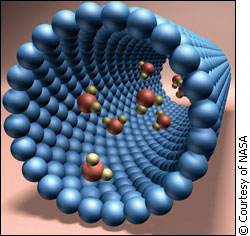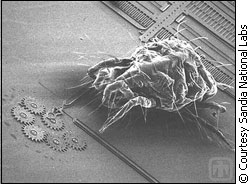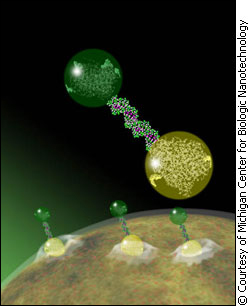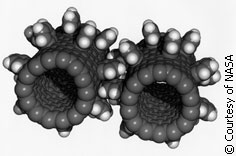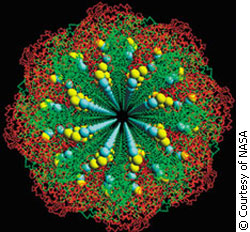
|
Nanoparticles and tiny terrors While nanomaterials are generally smaller forms of existing chemical compounds, they can exhibit new and unpredictable characteristics at this microscopic scale. “For example, gold at the ‘nano’ size appears red, but is still gold. Silver, on the other hand, looks blue,” says Benoit Simard, program leader at the Steacie Institute for Molecular Sciences in Ottawa. The rising concern is that chemicals which are benign at the macro scale, can exhibit toxic effects at the nano scale, or that they may be able to travel to parts of the human body that larger-sized particles can’t reach, says Mooney. Nano nano everywhere Today, nano materials can be found in skin creams, sunscreens and food applications. The Project on Emerging Nanotechnologies' Consumer Products Inventory is a catalogue of the nanotechnology-based consumer products currently on the market. This database, for example, lists more than 350 consumer products already on sale to the public, none of them specifically regulated as nanomaterials. “There’s a concern of putting it on your body, given the small size and the industry’s difficulty in controlling the size; it can enter the cells of your body, the blood brain barrier, the placenta and go undetected by the immune system — If that’s the case, it’s a major risk,” says Pat Mooney, executive director of ETC Group, an Ottawa-based non-profit organization that studies the environmental and social impact of emerging technologies.
Despite the risks, governments aren’t doing much to regulate this new technology. At present there are no laws in industrialized countries governing the manufacture or applications of nanotechnology. There is no requirement that a chemical compound being used at a macro scale be re-evaluated for use at a nano scale, even if its characteristics are completely different. What are the risks to regulate? A recent report in the science journal Nature criticized the federal government and Canadian industry for failing to mandate appropriate testing on nanotechnologies before releasing them to the public. The precautionary principle is not being exercised by governments and citizens should be concerned about it, says Mooney. Mooney says there probably are risks associated with this technology but the problem is that these risks have yet to be identified. "We're eating [nanotechnology], we're using it in all kinds of products that we wear on our skin and our clothing, and yet governments have no capacity to understand or regulate it."
Risk assessment: biological systems So far, there are two broad categories of risk assessment happening in this field: on biological systems and the environment. The first, biological systems, studies the effects of nanoparticles on individual cells up to more sophisticated organisms such as vertebrate animals. Kristen Kulinowski, director of the International Council on Nanotechnology at Rice University in Houston, Texas, says a lot of work has been done in this area, such as examining how nanoparticles interact with bacteria or how they accumulate in cells. “The good news is we're finding some simple ways to control the degree of a particle's toxicity, like sliding a dimmer switch on a lamp. This control means we can make the particle toxic only under certain desirable circumstances, such as when we want to cure a disease,” says Kulinowski.
At this point there have been relatively few studies done in this area of nanomaterials and as such, it is difficult to draw up a “big picture.” Some studies show that the body can process and excrete nanoparticles with no trouble. Others show that high concentrations of these particles can cause cellular damage. Kulinowski says nanomaterials have the potential to cause oxidative damage: to punch holes in cell membranes and kill cells in culture. Right now, she says, the question looking to be answered is: “how much is too much?” Risk assessment: The environment The second major category that is being considered is the environment. Studies are being done to understand how nanomaterials accumulate in the water or earth and if they pose a risk. Scientists want to figure out if they are disrupting the balance of bacteria in a water supply and what happens to nanoparticles after a long period of time if they become part of a waste stream. However, sustainability is the real issue, says Kulinowski. The goal at this point is to develop manufacturing processes and materials that have an environmentally benign lifecycle from the time they’re produced in the factory to when they end up in a landfill, says Mooney.
Nanotechnology: The potential cancer killer? Despite sometimes harrowing headlines, nanotechnology’s future isn’t so grim. Biomedical applications are at the top of the list of tools being developed from this technology. “’Nano cures cancer!’ -- I can't wait to see that headline, backed up by a solid body of peer-reviewed science,” says Kulinowski. Professor Jennifer West at Rice University is currently doing work that involves injecting nanoparticles into the body, where they naturally concentrate in tumor sites where there is a lot of blood flow into nearby tissue. Because these nanoparticles can be manipulated to respond to different wavelengths of light – depending on their size – they can tweaked to absorb a form of light that passes through healthy tissue but that can heat up the nanoshells to kill the cancer. Tests are ongoing at Rice University. Environmental benefits: Purifying our water Next comes environmental benefits, water purification systems are being revisited using nanostructured water-filtration membranes which, according to Kulinowski, could potentially solve the world’s drinking-water problems. These are filters with tiny pores that only allow certain molecules, such as water, to pass through while trapping larger particles like bacteria. While these kinds of membranes are currently made using different materials, nano-based materials may prove to be more effective and ultimately cheaper. “Right now we're using Victorian-era technology to clean and purify our water supplies,” says Kulinowski.
Nanoparticles under the microscope Although this technology holds a lot of promise, progress certainly won’t come overnight as laboratory science is meticulous and painstaking by nature. “But within three to five years, we'll have a better understanding of how to coat or chemically alter nanoparticles to reduce their toxicity to the body, which will allow us to broaden their use for disease diagnosis and for drug delivery,” says Simard. He says that within that same timeframe, there will be better understanding about how not to disturb the environment with these materials. Nanotechnology: A model for emergent technologies Meanwhile, promising new technologies often find themselves in the limelight of both alarmists and the hyperbolic. Genetically modified foods were once hailed as the miracle solution to world hunger, while simultaneously being labeled as the destroyer of the natural order. Nanotechnology is similar to its contentious predecessors in that it can either alleviate material need or eradicate humanity’s reign on Earth. It is because of its potential to change the world that there is rising public debate over its benefits and risks.
|
|
|
